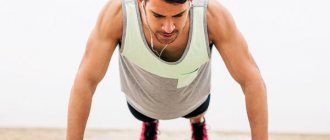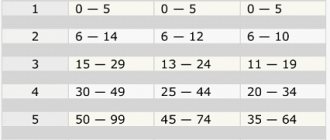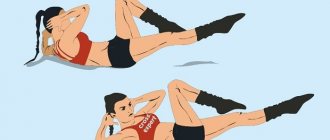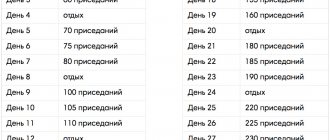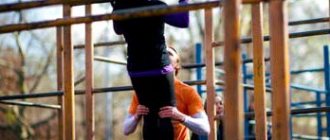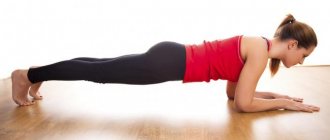For several years now, challenges have taken over the world. Some challenges entertain us, others motivate us to become better. Often athletes, and in our case a fitness blogger, set goals for themselves and invite their subscribers to complete them together. Some promised to jog for a whole year, others did pull-ups 100 times a day for a month. Our today's hero is Anton Marchuk - a young athlete challenged himself and did 200 push-ups every day for a month. What came of it? Now we'll tell you.
How to make push-ups effective?
Push-ups are considered one of the simplest and most effective exercises for keeping your body in shape. You can perform the exercise in different ways: either according to a special program or several approaches every day. Anton has repeatedly demonstrated both methods in his videos.
You won't be able to progress if you do the exercises dullly. You have to approach your training as if you were a boxer and this is your last fight. It shouldn't be like, "Damn, when is this training going to end." You need crazy eyes, you need to be on fire. Everything here depends solely on the mood.
Frequently asked questions
I couldn’t complete the entire number of repetitions, what should I do?
Each body has a unique system, some need more time to recover, others much less, so if you don’t do the required number of repetitions, don’t lose heart, rest for 1-2 days, gather your strength and try again to overcome this day, remember - “the morning is wiser than the evening.” "
How long to rest between sets of push-ups?
Usually the time for rest is 60 seconds, but if you yourself feel that this time is not enough, there is nothing wrong with a longer rest of 2-4 minutes. You shouldn’t rest any longer, as the muscles will lose their warmth and go out of “combat readiness” state.
How many times a week do you train?
It would be ideal to do push-ups every other day, since the muscles need time to recover; if you do push-ups every day, the muscles will become too tired and overtrained, and as a result you will not be able to do the planned number of push-ups.
The 100 push-ups program has been successfully completed, what next?
Next, in addition to push-ups with additional weight in the backpack, you can perform a variety of push-ups and try your hand at them.
So, the push-up pattern itself looks like this:
If you have completed all 6 weeks, then you are ready to achieve your main goal, rest for 1-2 days and do 100 push-ups in 1 set.
Train, may your health be strong and your muscles toned, good luck!
Tags: Home workouts
How to do push-ups correctly?
Pelvic position
You must feel the body. As it happens in the plank, it should be even and elongated. Any distortion will result in incorrect loading.
90 degree rule
You should lower yourself so that your arms are at 90 degrees to your body. At the same time, do not forget about the accuracy of performing the exercise - stretch your arms to the end.
What am I doing wrong? 5 common mistakes in push-ups
Head position
Don't turn your head. Direct your gaze to the floor and concentrate.
Long shoulders
If you sink in your shoulders, you won't have the proper load. Straighten up, raise your shoulders and stretch them all the way.
Pelvic position
You need to keep your back straight. Your tailbone should not live a separate life, tighten it and then the necessary muscles will be tense.
You can watch the detailed instructions in the video on Anton’s channel.
Hand push-ups: correct technique
The correct technique will ensure you achieve the desired result. By following the recommendations and instructions, you will eliminate the possibility of injuring your spine and joints.
Push-ups, due to the large number of contractions, involve the main muscle group of your body. If you perform the exercise systematically and correctly, the first effect you will achieve is an increase in endurance.
Correct push-up technique
Having chosen the right complex that takes into account the characteristics of your body, you need to adhere to a clear sequence of training. To increase efficiency, it is necessary to alternate different exercises, select the right load and give the body time to rest. When performing push-ups, the important criterion is not the quantity, but the quality of execution.
Goal: 200 reps per set
Anton Marchuk does not perform the challenge for show. According to him, challenges are needed to set new goals for oneself.
By the end of the month I should be able to do 200 push-ups in one set. I understand that this is a long process of self-improvement. For example, on the first day I did 200 reps in 15 minutes, which took about 13 sets of 10-15 reps at a time. Who said it would be easy? In 30 days you need to maximally improve your skill, and in the process become more resilient and stronger.
Anton published every training session on his Instagram. He did this solely so that people would not give up the challenge halfway and would continue to do the exercise with him. Unfortunately, not all of them were preserved in the tape. Let's take a look at one of them:
View this post on Instagram
Marchuk points out that push-ups should be alternated between different types. He realized that doing 200 reps with a regular classic grip was stupid. This should under no circumstances be done, as the same muscles will simply be used.
The fitness blogger also reminds us how muscles grow in general: by pumping up, for example, biceps, we first destroy them. After this, microtraumas form, but when the muscle fibers are restored, they become wider. This is how muscles are pumped.
How are push-ups selected? If you believe the Ukrainian athlete, then intuitively. A simple example: you have 50 push-ups left to do, but you won’t be able to do it with a classic grip. Firstly, this is wrong, as we wrote about above, and secondly, these muscles have tensed and there is no need to continue to force your body. It’s much easier to change your grip and get those same reps.
Physical activity during push-ups: how not to overdo it?
With any physical activity, it is necessary to correctly distribute the force of impact on the functioning of your body.
- The load can be quantitative - the number of exercises performed, and qualitative - depends on the intensity of the workout.
- The effect of the resulting physical activity is achieved with long-term constant training. Under the influence of force and sudden intensity of exercise, you risk getting a negative result.
- A distinction is made between constant and variable loads. With constant training, you work out every day, without setting aside days for rest. With a variable load, you give the body time to restore its performance.
The main thing is not to overdo it
- With proper physical activity, you will feel an improvement in muscle tone. After a good workout, your body should be hot and your appetite should be passive. When exercising above normal, the body experiences a sharp lack of nutrients, thereby increasing the feeling of hunger after exercise.
- In order to remove fat from a specific part of the body using push-ups, it is necessary to selectively select a set of exercises that target the desired muscle group.
- During the first workouts, fluid accumulates in the muscles, which compensates for weight loss. With prolonged exercise, the muscles dry out and you notice a decrease in body weight.
You need to eat at least an hour and a half before training. Your diet should include complex carbohydrates to ensure productive muscle function. To normalize metabolism during exercise, you need to drink water. After physical activity, warmed up muscles need replenishment. Eating a nutritious and healthy diet rich in proteins and amino acids after training will allow the body to convert nutrients into muscle mass.
It is important to remember that physical exercise is stressful for the body. Your task is to choose the right exercises, distribute the number of workouts, and follow the instructions.
Are there any benefits from push-ups?
Will your health suffer under such a heavy load? Daily physical activity in the form of exercise is a good preventive measure for blood stagnation and the prevention of heart disease. But what if we are talking about gaining muscle mass?
100 push-ups a day. Challenge that will change you in a month
Professional doctors unanimously insist that the restoration of those same muscle fibers that Marchuk told us about after active training occurs within 48 hours or more. What does it mean? We come to the conclusion that push-ups do not increase muscle mass. The human body simply does not have time to recover in such a short time. It is not recommended to perform serious loads every day, especially when we are talking about 200 push-ups. You begin to destroy yourself.
Our hero does not agree with this thesis:
You can do 200 push-ups every morning - that's 100%. I tested this on myself. Some say that something like this cannot be implemented, they say, it will destroy my body. How did I destroy myself? On the contrary, I worked out, did push-ups and improved in my performance. Moreover, during this time you improve your endurance.
How to achieve maximum results in hand push-ups?
In addition to push-ups, to achieve maximum effect, it is necessary to observe important points.
It is important to lead a healthy lifestyle
Factors influencing the achievement of results:
- Sequence of exercises. Gradual increase in load.
- Proper alternation of load and rest. Give your body time to recover.
- Nutritious meals to restore lost energy. Food rich in vitamins, proteins and amino acids.
- Healthy lifestyle. Eliminate bad habits.
- For push-ups to be effective, you need to have a trained abs. Add loads to your exercise routine to strengthen your abdominal and back muscles.
- When performing exercises, be precise and do not chase speed.
- If you feel tired or sore, take a break. Don't let your body become exhausted.
- Control your breathing while doing push-ups. The body lowers - inhale, the body rises - exhale.
Is there a result?
Anton says that he sees how his chest has become much larger. If earlier he could do two or three push-ups in a wallstand, now he can do 10 repetitions.
If we talk about push-ups, initially he could only do 25 repetitions with a regular classic grip per set, now this number has grown to 100. Let me remind you that he completed the first 200 push-ups in 13 approaches, and on the last day of the challenge he finished the exercise in only four.
More details about the numbers: 1 set - 100 repetitions, a minute of pause, second - 50 repetitions, 15 seconds of rest, third and fourth sets of 25 repetitions. 3-4 - 25 approaches.
Anton Marchuk confirmed that all this time he was studying in other programs. It is not known whether push-ups were the only thing that brought changes to the young fitness blogger’s body. In any case, the challenge was completed. But the goal was never achieved - 200 repetitions could not be completed at a time.
What happens if you do push-ups every day until muscle failure?
Of course, someone will think that 2-3 sets of 15-20 push-ups is too little and will decide to perform each approach until a state of complete muscle failure. But such loads for several days in a row will not bring any benefit, but on the contrary, will harm the body.
Some of the negative consequences of daily muscle failure include:
- Overfatigue and muscle exhaustion, which in turn will lead to a decrease in muscle volume;
- Constant feeling of fatigue in the shoulder girdle;
- Risk of injury and joint diseases.
Second week
Workout #1 (“Ladder”)
In the second week, we return to our classic “ladder” and try to surpass the results of the very first workout. For example, this time let's try to add four repetitions with each new approach to eventually reach 40 repetitions. The break between approaches can be from 10 to 40 seconds (no more).
After the “ladder” exercise, you can rest for about three minutes and move on to static exercises, which completes the first training day of the week.
Stand in a prone position, bend your elbows to 90 degrees and try to stand longer than last time. Now drop down, training is over.
Workout #2 (Static)
This time you will do the same six circles in two stances - on outstretched and bent arms, only now your approaches will last not 60 seconds, but as much as 80. You can rest for two to three minutes between approaches.
After this workout, you deserve a day of rest.
Workout #3 (Slow push-ups)
Do you also remember slow push-ups for ten seconds each? Now, each push-up you do will take a full 20 seconds - ten when lowering down and the same amount when lifting to the starting position. However, they must be done for the same one minute (that is, only three push-ups).
You also need to do five approaches, but, as you already understood, they will last the same amount of time. You can rest for three to five minutes.
Workout #4 (Simple push-ups)
Everything is the same as in the first week, just try to do more repetitions in one approach. We remind you that there should be five approaches, and the intervals between them can be from three to five minutes.
Charging the body with energy
Although exercise may not seem like the best way to revitalize your body, just a few push-ups can give you an energy boost that will help you regain your strength.
Movement improves blood circulation , your body accumulates additional heat and this makes your brain work more efficiently. Exercise is the best thing you can do almost anywhere and exercise, unlike energy drinks, is always available to you.
Increased metabolic rate
When you do push-ups, your body is tasked with working multiple muscle groups at the same time. This causes your heart to work faster to pump blood and your breathing quickens. The result of all this is an increase in metabolic rate, which is the key to easy and rapid weight loss and improved overall health.
By doing just one movement, you will get double the benefits, because push-ups serve as both aerobic exercise and strength training.
Third week
Workout #1 (Ladder)
We do the ladder in increments of five repetitions, rest from 10 to 50 seconds, and then after a three-minute pause we get into a static position and remain in it for as long as possible.
Workout #2 (Static)
All the same six circles (12 approaches), but now we try to stand in planks for 100 seconds. Rest for two or three minutes after each approach.
Workout #3 (Slow push-ups)
This time you will do one push-up for 30 seconds - 15 to go down, and the same number to get up. That's a total of two push-ups per minute.
There should be five repetitions, and the intervals between them can last from three to five minutes.
Workout #4 (Simple push-ups)
We are trying to set a new record within five approaches. We rest between approaches for the same amount - three to five minutes.
Stop procrastinating, it's time to start.
@bobbyatiedu_idk
If you keep promising yourself to start going to the gym to get closer to the appearance of Marvel superheroes, but for some reason you just can’t do it, we have a solution. This is a program of 100 push-ups in 6 weeks that will knock all the laziness out of you and restore the belief that you can punch a wall with your fist (but it’s better not to try).
The advantage of this program is that you never have to go to the gym, because you will do all the necessary exercises at home. Well, you can also impress your girlfriend and friends when, after the phrase “look, I can,” you do a hundred push-ups in one approach. When was the last time you performed something like this?
“But I practically can’t do push-ups.”
, - you will say and you will be more right than ever. However, fortunately for you, this program takes into account the fact that you are still a beginner athlete and you need to smoothly get into the rhythm.
All you need is a little persistence, a small piece of flooring and six weeks of strict adherence to all our instructions. In fact, not so much.
Kinds
From the floor
Classic push-up, in which both legs and arms are on the floor.
Usually, a person stands on the palms of his hands and on his toes, but you can also do push-ups on your fists, fingers or hands.
The exercise from the floor on the palms of the hands trains mainly the biceps, triceps, pectoral and deltoid muscles. The press also pumps.
From the knees
A more simplified version of the classic push-up, created for training people with less developed physical abilities.
It is performed in the same way as the classic exercise, but the person stands not on his toes, but on his knees. The load in this exercise is small, but for an untrained person it is significant.
The arm muscles (biceps, triceps), pectoral muscles and deltoids are also trained. The load on the press is much lower.
From the wall
Wall push-ups are one of the most difficult types of push-ups. Here, a huge load is placed on the arms and shoulder girdle, and in order to perform this exercise, you need to have serious physical fitness.
In order to complete the exercise, you need:
- Stand with your back to the wall, then lower your hands to the floor and take your starting position - on all fours.
- Climb the wall with your feet as high as possible, and pull your hands (in small steps) closer to the wall.
- Slowly bend your arms and lower yourself down until your head touches the surface.
- Then immediately straighten your arms and return to the starting position.
Wide grip
An exercise that is aimed at developing the pectoral muscles. In addition to the chest, the exercise also works well on the arms.
Done this way:
- We get into the starting position, as in a classic push-up (palms on the floor, feet on toes together).
- Then we spread our arms as wide as possible, while keeping our toes together.
- We do push-ups.
- When we go down, we inhale, when we go up, we exhale.
- You can complicate the task by adding additional supports for your arms and legs; in this case, you can go much lower, thanks to which additional muscle groups will be involved.
With a medium grip
Trains the arm muscles, abdominal muscles and shoulder girdle muscles. Also, the back muscles receive a huge load from static tension.
Push-ups are performed with a medium grip as follows:
- Starting position: standing on the palms of your hands and toes.
- The distance between the palms is slightly more than shoulder width.
- As you inhale, lower yourself down, touching the surface with your chest.
- As you exhale, rise up to the starting position.
- It is important that the head does not drop down too much and does not lift up.
With a narrow grip
Close-grip push-ups are performed to work the deltoids, triceps and pectoral muscles. Push-ups with a narrow grip are much more difficult than the classic type, which is why they are performed by people with good physical fitness.
Technique:
- Starting position: standing on your toes and palms of your hands.
- Place your palms together and place your toes shoulder-width apart.
- As you inhale, bend your elbows and lower yourself down, and as you exhale, rise up.
- In push-ups with a narrow grip, there are two options for raising the elbows: to the sides and along the body.
- If you move it to the sides, the load goes more on the chest and shoulder girdle.
- If the arms go along the body, then the load mainly goes on the shoulders and arms.
On one hand
Push-ups on one arm are needed in order to increase the load on certain muscle groups: deltoids, triceps, biceps, pectoral and others.
Mostly, people who are already able to perform several dozen classic push-ups and require additional load to develop their physical condition begin to do push-ups on one arm.
- Get into the starting position as in a classic push-up.
- Then spread your toes slightly and throw one arm behind your back.
- Bend your elbow and lower yourself down.
- Using maximum effort, push yourself out and try to rise up, taking the starting position.
- Do it several times and change the loaded hand.
With clap
The clapping exercise is performed to develop speed and strength qualities. The pectoral muscles, arm muscles and abdominal muscles are involved. Clapping push-ups are used in the training process of many athletes, so it is difficult to overestimate its importance and effectiveness.
In addition, the clapping exercise can be performed by both a professional athlete and a beginner. The only difference is the quality of execution, the number of times and the presence of complications.
Technique:
- We take a comfortable starting position.
- Toes and hands shoulder-width apart.
- Having dropped down a little, we sharply push ourselves up and at this time make a clap at chest level.
- We get into the starting position (the main thing is not to fall).
- We repeat the exercise several approaches 5-10 times.
In addition to regular clapping, you can also clap behind your back. This exercise is much more difficult than the previous one, but the result from its implementation will be significant.
Important! Before you try to do a clap behind your back, learn how to do a good push-up with a clap at chest level, since push-ups with a clap behind your back require serious reaction and speed, and if you do not have this, you can simply fall on your nose to the floor and get injured.
On fingers
Push-ups on the fingers are a little different from other types of push-ups, since the load here goes to the wrist area and develops the strength of the fingers. There are also different types of finger push-ups: push-ups on all fingers, push-ups on one finger, push-ups on three fingers and others.
Performance:
- Take the starting position, as in a classic push-up.
- Then, from the palm stand, stand on your fingers (it is very important to learn how to hold yourself in this position so that your fingers do not move apart).
- Perform push-ups, 3 sets of 3-5 times.
In the future, when your fingers get stronger and your arm muscles become stronger, you will be able to do dozens of push-ups without pain or much effort.
With weights
When doing push-ups with weights, the main emphasis is on the load on the muscles.
By “weights” we mean dumbbells, various special equipment, as well as a partner, who can be placed on the back or asked to apply a little pressure from above to increase the load when extending the arms and lifting.
The latter method is very effective, since the load can be doubled or more.
For this:
- Take the starting position: stand on the palms of your hands and toes.
- Start doing standard push-ups (to warm up).
- Then ask your partner to apply a little pressure with his hands on his back and increase the pressure each time.
- If this is not enough, ask your partner to sit on your back, but it is important that the weight of your partner does not cause you pain.
- Perform push-ups until you realize that your strength is running out.
- After the push-ups, do some light stretching to tone your muscles.
If the method with a partner is not suitable, you can put a barbell plate on your back (select the weight individually, it should be noticeable, but not too heavy).
And if push-ups are performed at home, and you don’t have a barbell plate at hand, you can use improvised means, such as:
- Packets of cereal.
- A bag of flour or sugar.
- A bag filled with things and other things.
Fourth week
Workout #1 (Ladder)
We welcome week four with the good old staircase, which forces you to increase your stride up to six repetitions. By the way, with such an impressive number of push-ups, you can rest longer between approaches - from ten seconds to two minutes.
After the “ladder” we rest a little and get into a classic plank position with the goal of breaking the previous time record. We fall.
Workout #2 (Static)
These are six circles of classical statics, but now each approach should last two minutes, and you can still rest the same - two to three minutes.
Workout #3 (Slow push-ups)
It would seem much slower? It turns out there is somewhere. Now you have to spend a whole 40 seconds on one push-up (20 down and 20 up), and you will have to do two of them, which will take not a minute, but 80 seconds.
There should be five approaches, and you can rest for two to three minutes.
Workout #4 (Simple push-ups)
We hope you already remember everything - five sets of the highest number of repetitions. We reach new heights.
How to build muscle mass with push-ups
This is not an easy task, since most of the work occurs with your own weight, and for muscle growth you need a constant progression of load. You can be smart and put a weight on your back, but it will soon not be enough. But even without additional weight, push-ups can build some muscle.
The load in this case is regulated by the speed of the exercise. Muscles don’t count kilograms; they care about working hours. Spend 3 seconds lowering your body and 2 seconds rising.
An increase in load is also ensured by an increase in the amplitude of movement. To do this, place several books under your palms or use special platforms. In addition, if you place your feet on a hill, the exercise will become even more difficult.
So, if you want your muscles to grow, do the exercise at a slow pace, increase the range of motion using platforms and the position of your legs relative to your head.
How many times should you do push-ups? Perform 8-10 reps in 4-5 sets. Shift your workouts to a day of rest. Take a break of no more than 1 minute between approaches.
| Do not forget that muscle mass growth is possible only with good rest (at least 8 hours) and “building material” for growth, that is, adequate protein intake. A good whey protein, for example, one of the most affordable among foreign ones - Ultimate Nutrition Prostar Whey, with its 25 g of protein per serving, is ideal for muscle growth. You can learn more about protein in The Complete Guide to Protein. |
100 push-ups program
This program will help you reach your desired goal of 100 push-ups. In addition to following the program, you need to eat right and engage in additional physical activity (running, stretching, team sports).
Be sure to warm up and stretch before each workout. Particular attention is paid to the shoulder girdle and joints. Don't quit what you started halfway.
If you feel that you don’t have the strength to train further, reduce the number of push-ups to the norm that will be comfortable for you and continue to increase it.
So, an approximate workout for a month:
| Day | Approaches, number of times |
| Monday | First set: 20 Second set: 17 Third set: 15 Fourth set: 13 Fifth set: 10 |
| Tuesday | First set: 22 Second set: 18 Third set: 15 Fourth set: 13 Fifth set: 11 |
| Wednesday | First set: 24 Second set: 18 Third set: 17 Fourth set: 14 Fifth set: 11 |
| Thursday | First set: 25 Second set: 20 Third set: 17 Fourth set: 15 Fifth set: 12 |
| Friday | First set: 28 Second set: 23 Third set: 18 Fourth set: 16 Fifth set: 12 |
| Saturday | First set: 30 Second set: 25 Third set: 19 Fourth set: 17 Fifth set: 14 |
| Sunday | First set: 33 Second set: 27 Third set: 20 Fourth set: 18 Fifth set: 15 |
| Monday | First set: 35 Second set: 30 Third set: 22 Fourth set: 18 Fifth set: 15 |
| Tuesday | First set: 38 Second set: 33 Third set: 24 Fourth set: 19 Fifth set: 16 |
| Wednesday | First set: 40 Second set: 35 Third set: 27 Fourth set: 21 Fifth set: 17 |
| Thursday | First set: 43 Second set: 38 Third set: 30 Fourth set: 23 Fifth set: 18 |
| Friday | First set: 45 Second set: 40 Third set: 32 Fourth set: 25 Fifth set: 18 |
| Saturday | First set: 47 Second set: 42 Third set: 34 Fourth set: 26 Fifth set: 20 |
| Sunday | First set: 49 Second set: 45 Third set: 37 Fourth set: 28 Fifth set: 21 |
| Monday | First set: 51 Second set: 48 Third set: 40 Fourth set: 29 Fifth set: 21 |
| Tuesday | First set: 53 Second set: 50 Third set: 43 Fourth set: 33 Fifth set: 23 |
| Wednesday | First set: 55 Second set: 50 Third set: 44 Fourth set: 34 Fifth set: 24 |
| Thursday | First set: 57 Second approach: 52 Third set: 46 Fourth set: 36 Fifth set: 25 |
| Friday | First set: 59 Second approach: 53 Third set: 49 Fourth set: 39 Fifth set: 26 |
| Saturday | First approach: 62 Second set: 55 Third set: 49 Fourth set: 43 Fifth set: 28 |
| Sunday | First approach: 64 Second approach: 59 Third set: 52 Fourth set: 45 Fifth set: 30 |
| Monday | First set: 67 Second set: 61 Third set: 55 Fourth set: 49 Fifth set: 33 |
| Tuesday | First set: 70 Second set: 65 Third set: 57 Fourth set: 53 Fifth set: 35 |
| Wednesday | First approach: 74 Second approach: 69 Third set: 60 Fourth set: 56 Fifth set: 35 |
| Thursday | First set: 78 Second approach: 72 Third set: 63 Fourth set: 59 Fifth set: 37 |
| Friday | First approach: 82 Second set: 77 Third set: 67 Fourth set: 62 Fifth set: 39 |
| Saturday | First set: 87 Second set: 80 Third set: 70 Fourth set: 65 Fifth set: 41 |
| Sunday | First set: 90 Second set: 85 Third approach: 74 Fourth set: 69 Fifth set: 43 |
| Monday | First approach: 94 Second approach: 88 Third set: 78 Fourth set: 72 Fifth set: 45 |
| Tuesday | First approach: 98 Second approach: 93 Third set: 80 Fourth set: 74 Fifth set: 48 |
| Wednesday | First set: 100 Second approach: 93 Third approach: 84 Fourth set: 76 Fifth set: 50 |

